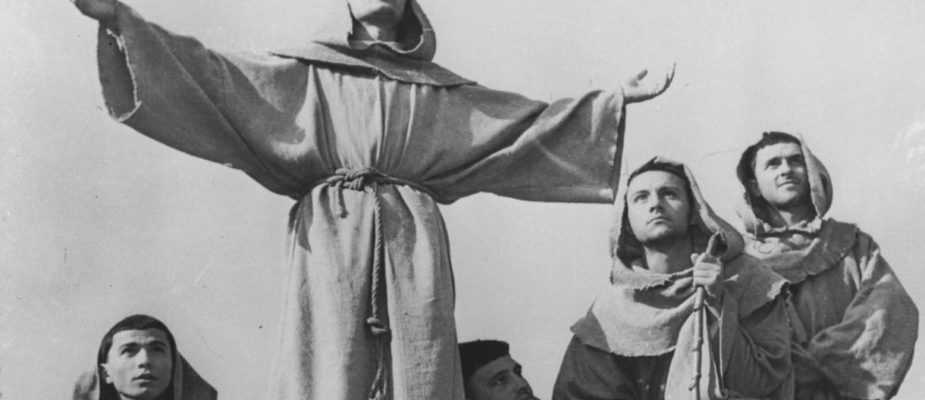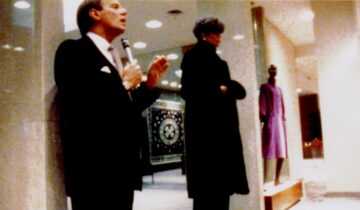Roberto Rossellini’s 1950 masterwork The Flowers of St. Francis, whose Italian title, Francesco, giullare di Dio translates as “Francis, God’s Jester,” seeks less to tell the story of its saint’s life than to show the impact of “the Franciscan message… and spirit” on its followers. This axiomatic expression of Italian neorealism depicts both scenes from the life of the titular St. Francis of Assisi (Brother Nazario Gerardi, a real-life Franciscan monk), and also dramatizations of his fellow friars’ experiences with Franciscan monastic life – with the latter group played by uncredited members of the Nocere Inferiore monastery.
Rossellini’s film opens with the friars beginning their mission amidst a torrential storm, and ends with the men playing a game to decide where each will disperse to, after locals offer alms to the impoverished friars. In between these book-end sequences, their lives are depicted in a series of vignettes that collectively suggest a certain randomness, at least with respect to their occurrence in time – which is to say that Flower’s narrative is not necessarily sequential. As to the episodes themselves, each is introduced with an intertitle (and an organ interlude; music otherwise is used rarely in The Flowers of St. Francis). Included among these are ‘How Brother Ginepro returned naked to St. Mary’s of the Angels, where the brothers had finished building their hut,’ ‘How Giovanni, known as “the simpleton” asked to follow Francis and began imitating him in word and gesture’ and ‘How Francis, praying one night in the woods, met the leper.’
The last depicts an event noted by a number of the saint’s biographers. For instance, in the four volume Butler’s Lives of the Saints, Francis’s hagiographer details the scene as follows: “Riding one day in the plain of Assisi he met a leper, whose sores were so loathsome that at the sight of them he was struck with horror. But he dismounted, and as the leper stretched out his hand to receive an alms, Francis, whilst he bestowed it, kissed the man.” Indeed, in this account there emerge slight differences from the film, such as its occurrence in the day rather than at night (as it appears in Rossellini’s work). Still, Rossellini’s presentation of the events, less a few minor details, retains the spirit if not the authenticity of the historical account – a spirit and moment, in this case, that is as purely Christian as any that has ever appeared on the screen.
Then again, the historical authenticity of The Flowers of St. Francis has little bearing on the film as a work of art. Certainly, it is less important for an understanding of The Flowers of St. Francis than it was for the director’s signature achievement, Rome, Open City (1945), for example. In the 1950 film, the details of Francis’s life are less essential than are the decisions the authors (Rossellini and screenwriter Francesco Fellini, La Dolce Vita) have chosen to represent – and to be sure the form that has been adopted for the film. Regarding the latter, the key significance of the episodic narrative is that it has generated a temporal model that can be regarded as uniquely Christian: that is, time does not simply pass in The Flowers of St. Francis, in the movement from life to death, but is instead suspended through the episodes that eschew specific relations to a time in Francis’s life. Surely, there is a beginning – “So Francis, to vanquish the world, made himself contemptible and humble. He became a child in order to be worthy of the kingdom of heaven.” – and there is an end, “How Francis left St. Mary of the Angels with the Friars and preached throughout the world.” Yet, it is what falls in between, in the interim, which establishes the film’s distinctly Christian temporal mode. Or, even more specifically, its cyclical, Roman Catholic time structure, one that seems to replicate that faith’s liturgical division of the year.
Indeed, it is this concept of a “kingdom of heaven” that influences Rossellini’s rethinking of temporality – where ‘the life of the world to come’ is established in this life. Existence with the friars, possession-less and without desire for worldly gain, prefigures the after life, which is to be understood in terms of an eternal communion with the divine, divorced from individual property or gain. In that life, as in the corporeal existence of the friars, everything is directed toward a worship of the Godhead. They efface themselves in committing themselves completely to the directed worship of the divine through acting on His behalf. Consequently, the following Christian axiom is fulfilled in their choice of vocation: “For whoever wishes to save his life shall lose it, but whoever loses his life for my sake, he is the one who will save it.” In other words, the friars gain eternal life, but importantly this life begins not after death but in their daily existences. As such, the sting and significance of death is reduced to the degree that life will continue unabated for these brothers once they pass over to the other side – though it will no longer be ‘through a glass dimly’ that they understand.
This then is the relationship of Christian thought to The Flowers of St. Francis’ temporal structure: namely, in figuring eternal life by mitigating time’s passage and as such the death that such transience automatically inscribes. Of course, Rossellini did not invent the episodic structure nor are all episodic films ‘Christian.’ Rather it is that in this case, through the manipulation of standard form, a particular idea or worldview has found its articulation in the picture’s structure.
Consequently, one might ask from whence has Rossellini’s structure come? While certainly there are manifold examples of episodic narrative structure from the silent era on – Intolerance (1916) is a defining example; and in the director’s own career, Paisan (1946) – additional precursors to The Flowers of St. Francis emerge in literature and especially in icon painting. Though the director expressly warns against interpreting his film according to the former, there are instances of hagiographic content, as has been noted above. In terms of the latter, the episodic structure suggests a basic congruence, though not exactly influence. To take just one example, a thirteenth century Saint Catherine with Scenes from Her Life is sufficiently descriptive: here a central image of the saint is surrounded by scenes that dramatize her life with no particularly emphasis placed on their arrangement. However, the effect of the flanking scenes is proto-cinematic as it narrates the saint’s life, adding propositional content to the figure at the center of the panel – that is, Saint Catherine who experienced such-and-such forms of tortures, etc. It is her story, told in an episodic format, just as The Flowers of St. Francis conforms to a similar structure. To be sure, it is possible to imagine a portrayal of the same subject matter in a painting that would share Saint Catherine with Scene’s from Her Life’s form: with a portrait of St. Francis and his “flowers” in the center, abutted by the scenes from their lives.
Of course, The Flowers of St. Francis is by no means the best known of the director’s episodic pictures. This distinction goes to his Paisan, which at the same time, submits to a different structure than The Flowers of St. Francis inasmuch as the characters vary from scene to scene. At the same time, the theme of time’s suspension remains integral to at least one of the six segments, the fifth. Here, in the Franciscan, Apennine monastery section, repeated reference is made to the present’s unity with the past: “this time of the evening 500 years ago,” and “the footsteps of monks for 500 years.” Indeed, Rossellini is suggesting a life that remains unchanged, and is therefore very much out of time (which positions the episode in direct contrast to the other very timely segments of Paisan) in much the same manner again as the Catholic faith’s liturgical division of the calendar year. These men too are seeking to conform themselves to the will of God and to begin eternity in this life, though in contrast to St. Francis, the film’s multi-episode structure interrogates this decision to be apart from rather than in the world. Besides which, charity is the central focus of St. Francis’s gospel in the film that bares his name. The friars are anything but outside the world.
This post originally was published as part of a longer academic essay by the author on the director’s work, “Rossellini & Sainthood.” The essay is available in its entirety here.
The Flowers of St. Francis screens twice on 35mm at the Samuel Roberts Noble Theater on Thursday, January 5th, at 5:30 and 8 pm.










